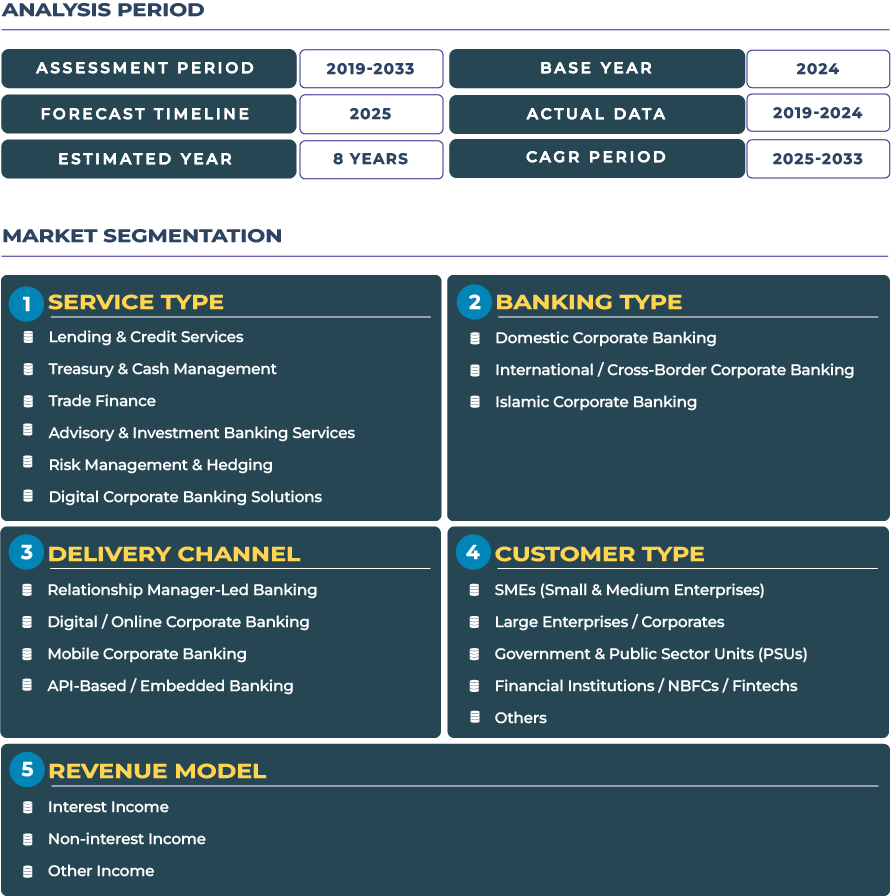Fintech-Driven Corporate Cash and Liquidity Solutions in South Korea: Enhancing Efficiency and Transparency
South Korea corporate banking ecosystem is undergoing a profound transformation as fintech innovation reshapes liquidity, treasury, and cash management operations across the enterprise sector. As the nation’s large conglomerates (chaebols) and export-driven corporations seek operational agility and real-time financial visibility, banks are rapidly deploying fintech-powered tools such as open API banking, automated reconciliation systems, and AI-based liquidity forecasting. This fintech integration is strengthening the resilience and transparency of corporate finance workflows, positioning South Korea as one of Asia’s most advanced corporate banking markets.
Note:* The market size refers to the total revenue generated by banks through interest income, non-interest income, and other ancillary sources.
According to DataCube Research, the South Korea Corporate Banking Market is expected to expand from USD 52.8 billion in 2025 to USD 67.1 billion by 2033, registering a CAGR of 3.0%. This growth reflects the synergy between South Korea’s globally competitive manufacturing base, spanning electronics, automotive, and shipbuilding, and the rapid adoption of digital financial infrastructure. The government’s fintech-friendly policies, high-speed digital connectivity, and sophisticated corporate clientele are driving banks to innovate faster, particularly in cash management and liquidity automation. As corporate banking institutions enhance efficiency and transparency through technology integration, the industry is redefining its value proposition for the next generation of Korean enterprises.
Market Drivers & Restraints: Navigating Chaebol-Centric Finance and Digital Competition
Chaebol Global Expansion and Fintech Integration Drive Corporate Banking Growth
South Korea corporate banking growth is primarily fueled by the globalization of its leading conglomerates such as Samsung, Hyundai, and LG, whose multinational operations require integrated global treasury systems. These enterprises demand cross-border liquidity management, multi-currency credit lines, and real-time trade finance capabilities, encouraging banks to offer more sophisticated fintech-driven treasury platforms. The increasing reliance on Financial Services Commission (FSC)-approved open banking frameworks has further enabled institutions to connect directly with corporate ERPs and automate financial workflows. High-tech exporters, particularly within the semiconductor sector, are leveraging customized FX hedging and cross-border trade finance products to stabilize margins amid currency volatility. The combination of advanced financial APIs, seamless data integration, and efficient cash cycle management continues to position South Korea as a regional benchmark for fintech-enabled corporate banking innovation.
Concentration in Chaebols and Competitive Pressure Restrain Market Diversification
However, the market’s concentration within a few large chaebols poses structural limitations for diversification. Smaller and mid-sized enterprises often face higher entry barriers to advanced banking services, restricting broad-based adoption of digital corporate solutions. Furthermore, regulatory oversight remains tight, especially in managing conglomerate banking relationships and intra-group financing, limiting the flexibility of banks to innovate at scale. The emergence of aggressive fintech startups and non-bank financial platforms offering low-cost payment and treasury solutions has also intensified margin pressure on traditional banks. These competitive dynamics are forcing South Korean lenders to rebalance their portfolios, invest in technology partnerships, and redesign client servicing models to maintain profitability in an increasingly digital-first corporate banking environment.
Trends & Opportunities: Shaping the Future of Corporate Treasury and ESG-Linked Lending
ERP Integration and Semiconductor Supply Chain Financing Define Market Transformation
One of the most transformative trends in South Korea corporate banking industry is the seamless integration between corporate ERP systems and bank platforms. This evolution allows CFOs to manage liquidity positions, execute payments, and monitor cash flows in real-time through direct API connectivity. The semiconductor industry, dominated by giants such as Samsung Electronics and SK Hynix, is particularly benefiting from bank-supported export finance programs that address the working capital needs of global supply chains. Leading institutions are aligning with the national semiconductor strategy to build specialized trade finance desks that support suppliers and component manufacturers engaged in high-value exports. In parallel, the rise of digital treasury ecosystems is enabling predictive liquidity management, automated invoicing, and enhanced credit decisioning across industries.
Sustainability and Supply Chain Finance Create New Lending Opportunities
As South Korea pursues its Net Zero 2050 goals, corporate banks are expanding sustainability-linked loan products for industrial clients. ESG-oriented financing is emerging as a mainstream opportunity, particularly for heavy industries, shipbuilders, and tech manufacturers aiming to decarbonize operations. Green capital expenditure loans and carbon reduction-linked revolving facilities are gaining traction, supported by favorable policy frameworks. In addition, the growing complexity of global trade networks is prompting banks to launch advanced supply chain finance programs tailored to semiconductor and auto component suppliers. These initiatives not only mitigate liquidity risks but also help strengthen Korea’s strategic export position, ensuring long-term competitiveness in global markets.
Competitive Landscape: Strategic Innovation Among Leading Corporate Banking Institutions
South Korea corporate banking landscape is defined by robust competition among major domestic players such as KB Financial Group, Shinhan Financial Group, and Hana Bank, alongside international institutions expanding their regional presence. In 2024, KB Financial announced an expansion of its AI-integrated cash management suite targeting mid-cap exporters, while Hana Bank launched a multi-currency treasury solution enabling real-time FX optimization for corporate clients. Shinhan Bank has partnered with fintech startups to develop blockchain-based trade finance systems aimed at improving documentation efficiency and transparency.
Strategically, South Korean banks are creating semiconductor-focused finance desks to serve high-tech manufacturers, developing multi-currency hedging bundles to help exporters manage volatility, and expanding sustainability-linked credit lines for heavy industries. These tailored strategies are designed to match sector-specific cycles and align with the country’s broader industrial policy. The fusion of fintech collaboration, sustainability mandates, and cross-border financing capabilities underscores the sector’s agility and commitment to innovation. As a result, South Korea corporate banking industry is emerging as one of the most forward-looking and resilient ecosystems in Asia.







